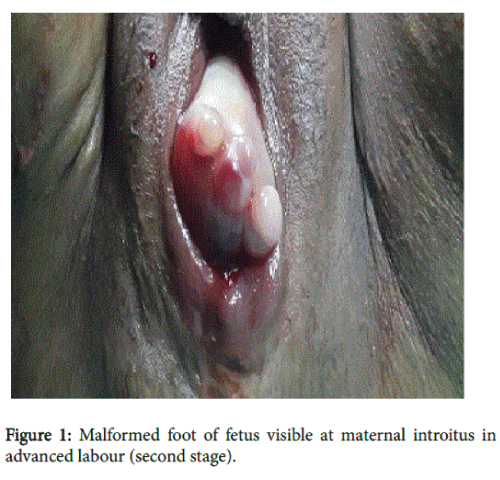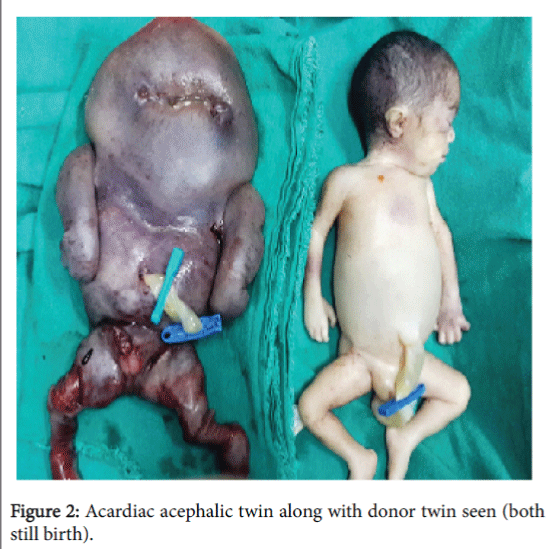Case Report Open Access
Acardiac Acephalus Fetus Presenting as Obstructed Labour: A Case Report
Manupriya Sharia1 and Chanderdeep Sharma1*
Dr Rajendra Prasad Government Medical College, Kangra, Himachal Pradesh, India
- *Corresponding Author:
- Chanderdeep Sharma
Dr Rajendra Prasad Government Medical College
Kangra, Himachal Pradesh, India
Tel: 91-9218925471
E-mail: cdsharma2006@gmail.com
Received date: March 22, 2016; Accepted date: May 26, 2016; Published date: May 29, 2016
Citation: Sharia M, Sharma C (2016) Acardiac Acephalus Fetus Presenting as Obstructed Labour: A Case Report. J Preg Child Health 3:255. doi:10.4172/2376-127X.1000255
Copyright: © 2016 Sharma C. This is an open-access article distributed under the terms of the Creative Commons Attribution License, which permits unrestricted use, distribution, and reproduction in any medium, provided the original author and source are credited.
Visit for more related articles at Journal of Pregnancy and Child Health
Abstract
Mono-amniotic mono-chorionic pregnancies are un-common among twin gestations. Further twin reversed arterial perfusion (TRAP) sequence is extremely rare presentation. Acardiac acephalic fetus resulting as a result of TRAP sequence has an estimated incidence of 1 in 35,000 pregnancies. To the best of our knowledge, no such case has been reported till date which presented as obstructed labour. We are highlighting this case so as to alert the managing team of obstetricians regarding this rare cause of obstructed labour. Also to increase awareness regarding this presentation presenting in advanced second stage of labour with fetal malpresentation. Only diagnostic pointer in index case was malformed fetal toes visible at introitus of mother in advanced second stage of labour.
Introduction
Acardiac acephalic fetus is a very rare complication of monozygotic twin pregnancy. The estimated incidence of this complication is 1 in 35,000 pregnancies [1]. It results from abnormal placental vascular anastomosis [2]. Usually this condition is diagnosed on routine ultra sonographic examination. We report this rare condition in a tribal woman with no previous antenatal examination presenting as obstructed labour.
Case Report
A 24 year old woman gravida [2], para [1], at 37 completed week’s gestation came to emergency room in labour. She was referred as a case of obstructed labour. She did not have any antenatal check-up or ultrasonic examination prior to this visit. Her previous delivery was an uncomplicated normal vaginal delivery. On examination she was dehydrated and exhausted. Her breath had acetone like smell. On abdominal examination uterus appeared to be over distended, tense and tender. Fetal heart could not be localized. Vulva was oedematous and swollen. Foot of the fetus was seen protruding out of the vulva (Figure 1).
However, this foot appeared deformed as only three toes were visible. On vaginal examination, cervix was fully dilated and effaced. An attempt was made to deliver the fetus vaginally but it leads to peeling of the fetal skin at the knees. With clinical diagnosis of obstructed labour an emergency sonogram was requested which revealed twin pregnancy with intra-uterine fetal death of both the twins. No inter twin membrane could be seen. However, note was also made of inability to localize two separate fetal heads. So with a presumptive diagnosis of twin pregnancy with obstructed labour emergency caesarean section was done. Intra-operatively, twin pregnancy was confirmed. The first fetus (donor twin) was fresh still birth with no gross anomaly externally. The second fetus (recipient twin) was macerated with absent head, and upper portion of the torso contained only soft globular mass. The right foot of the second fetus had one toe whereas left foot had three digits. The lower spinal column and lower limb bones were apparently normal. The weight of the two foetuses was 2100 g (donor twin) and 4500 g (recipient twin) respectively; placenta was single and weighed 800 g. A diagnosis of monoamniotic monochorionic twin pregnancy with acephalic twin was made. Subsequently, both the fetuses and placenta were sent for autopsy, which confirmed the diagnosis of monoamniotic monochorionic twin pregnancy with acardiac acephalus fetus with twin reversed arterial perfusion (TRAP) sequence. Head, heart, lungs and upper limbs were absent in the acardiac twin. The soft globular mass (appearing as head) was actually edematous liver with multiple fluid filled cavities. Subsequently, mother had an uneventful postoperative period (Figure 2).
Discussion
Acardiac acephalic twin pregnancy is one of the rarest and unique complications of monozygotic twin pregnancy [1]. Four types of acardiac fetuses have been described in the literature [3].
• acardiac-acephalus (no cephalic development)
• acardius-anceps (some cranial structures with or without neural tissue)
• acardius-acormus (cephalic structures with limited or no truncal development)
• acardius-amorphus (no cephalic or truncal differentiation)
The index case was acardiac acephalus. The TRAP sequence seen in the index case chiefly results from abnormal placental vascular anastomoses with consequent increase in arterial pressure in one twin leading to reversal of blood flow in the other twin. As a result, the “donor” twin pumps deoxygenated blood into the “recipient” (acardiac) twin [1]. A variety of anomalies can occur due to severe hypoxemia, which in the index case was acardiac acephalus twin.
Widespread use of sonography has resulted in early diagnosis of this condition even in first trimester. However, in the index case woman did not have any ante-natal ultrasonographic examination and presented in second stage as obstructed labour. Due to malformed externally visible foot (with only three toes; as shown in Figure 1), a high index of suspicion of some major malformation was suspected. Emergency ultrasound could detect only one fetal head, so a possibility of acephalic fetus was suspected. To the best of our knowledge, this is the first case report in literature where acardiac acephalic monochorionic pregnancy presented in second stage as obstructed labour.
This case is being presented to make the managing obstetricians aware regarding this extremely rare presentation presenting as obstructed labour. A high index of suspicion and timely intervention in terms of emergency caesarean section was detrimental in saving life of the mother.
Conflict of Interest
There is no conflict of interest with any individual or organization.
References
- Sogaard K, Skibsted L, Brocks V (1999) Acardiac twins: pathophysiology, diagnosis, outcome and treatment. Six cases and review of the literature. FetalDiagn Therapy 14: 53-59.
- Rohilla M, Chopra S, Suri V, Aggarwal N, Vermanni N (2008) Acardiac-acephalus twi ns: A report of 2 cases and review of literature. Medscape J Med. 10: 200.
- Chen CP, Shih SL, Liu FF (1997) Skeletal deformities of acardiusanceps: The gross and imaging features. PediatrRadiol 27: 221-225.
Relevant Topics
Recommended Journals
Article Tools
Article Usage
- Total views: 18051
- [From(publication date):
June-2016 - Aug 31, 2025] - Breakdown by view type
- HTML page views : 17043
- PDF downloads : 1008


